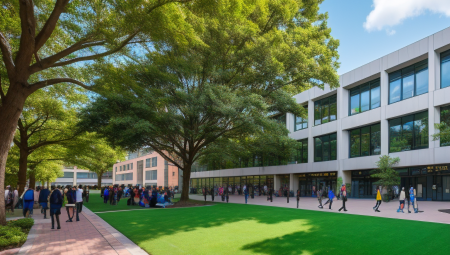Are you tired of traditional university programs that confine you to a single department and limit your learning potential? It’s time to break free from the old ways and explore the exciting world of interdisciplinary programs. In recent years, there has been a significant rise in the popularity of interdisciplinary education in US universities, and for good reason. This revolutionary approach to learning breaks down departmental silos, promotes collaborative learning, and creates innovative opportunities for students to combine expertise from various fields. In this blog post, we will delve into the world of interdisciplinary programs and explore the impact they are having on both students and educational institutions. From addressing real-world challenges to creating new career opportunities, interdisciplinary education is revolutionizing the way we learn and grow. So, join us as we explore the rise, challenges, and future prospects of interdisciplinary education in US universities.
Table of Contents
The Rise of Interdisciplinary Programs
In today’s rapidly evolving world, the traditional academic structure is being challenged by the emergence of interdisciplinary programs. These programs are designed to break down the departmental silos and promote collaborative learning among students from different fields of study. The rise of interdisciplinary programs reflects a growing recognition of the limitations of traditional, discipline-specific education and a need for a broader, more holistic approach to learning.
By bringing together students and faculty from diverse backgrounds, interdisciplinary programs encourage innovative approaches to curriculum design. This allows for a more comprehensive understanding of complex issues and challenges, and fosters the development of critical thinking and problem-solving skills from a variety of perspectives.
Furthermore, interdisciplinary research is a key component of these programs, as it combines expertise from multiple disciplines to address real-world problems and create new knowledge. This approach not only creates exciting career opportunities for students with multidisciplinary skills, but also makes a meaningful impact on addressing global challenges.
As the demand for professionals who can address real-world challenges continues to grow, the need for interdisciplinary programs becomes increasingly apparent. Educational institutions are now tasked with overcoming challenges in resource allocation to support and enhance these programs, while also finding ways to engage and motivate students in this new learning paradigm.
Breaking the Departmental Silos: Collaborative Learning
Collaborative learning is a powerful approach to breaking down the traditional barriers between different academic departments. By encouraging students to work together across disciplines, universities can foster a more holistic and integrated approach to education. Rather than siloing off knowledge in separate departments, collaborative learning promotes the exchange of ideas and perspectives, enriching the learning experience for all involved.
One of the key benefits of collaborative learning is the opportunity for students to develop a deeper understanding of complex issues by drawing on diverse knowledge sets. For example, a project that combines the insights of engineering, sociology, and economics can provide a more comprehensive understanding of a real-world problem, compared to a single-discipline approach. This not only enhances students’ critical thinking and problem-solving skills, but also prepares them for tackling multifaceted challenges in their future careers.
Breaking down departmental silos also encourages innovation in curriculum design. By creating opportunities for interdisciplinary collaboration, institutions can develop more flexible and adaptable programs that reflect the complex, interconnected nature of modern society. This can lead to the creation of more relevant and dynamic courses that better prepare students for the rapidly changing demands of the workforce.
Furthermore, collaborative learning can foster mutual respect and understanding between different academic disciplines, breaking down preconceptions and stereotypes. By working together on shared projects, students and faculty can gain a greater appreciation for the value of diverse perspectives, leading to a more inclusive and supportive academic community.
Innovative Approaches to Curriculum Design
Curriculum design is a crucial aspect of education, shaping the learning experience for students and guiding the teaching process for educators. In today’s rapidly evolving world, traditional curriculum models are being reexamined to meet the needs of 21st-century learners.
One innovative approach to curriculum design is incorporating project-based learning into the academic framework. This hands-on, experiential method allows students to apply their knowledge to real-world challenges, fostering critical thinking and problem-solving skills.
Another innovative approach is the integration of technology into the curriculum. By leveraging digital tools and resources, educators can create dynamic and interactive learning experiences that cater to diverse learning styles and preferences.
Furthermore, personalized learning pathways are gaining traction as an innovative approach to curriculum design. This approach recognizes that students have unique strengths, interests, and learning paces, allowing for customized learning experiences that better engage and motivate students.
Interdisciplinary Research: Combining Expertise
Interdisciplinary research is a powerful approach that involves the combination of expertise from different disciplines to address complex real-world challenges.
By bringing together diverse perspectives and knowledge, interdisciplinary research can lead to innovative solutions that would not be possible through a single-discipline approach.
This collaborative approach facilitates the exchange of ideas and methodologies, leading to a more comprehensive understanding of the problem at hand.
Furthermore, interdisciplinary research can help to bridge gaps between academic disciplines, fostering a culture of collaboration and mutual respect.
Creating Career Opportunities: Multidisciplinary Skills
The demand for multidisciplinary skills in the workplace is on the rise as employers seek individuals who can bring a diverse range of expertise to the table. This trend is creating new and exciting career opportunities for professionals who possess the ability to work across different disciplines and collaborate with colleagues from varying backgrounds.
By developing a multidisciplinary skillset, individuals can position themselves as valuable assets to organizations looking to solve complex problems that require a holistic approach. Whether it’s a project management role that involves coordinating efforts across departments or a research position that calls for an understanding of both engineering and design principles, professionals with multidisciplinary skills are in high demand.
Employers are recognizing the value of multidisciplinary skills and are actively seeking out candidates who can bring a fresh perspective to their teams. This has opened up a wealth of career opportunities for individuals who are able to bridge the gap between different areas of expertise and add significant value to their organizations.
As the job market continues to evolve, it’s clear that individuals with multidisciplinary skills will have a competitive edge in securing fulfilling and impactful careers. By honing their abilities to work across disciplines and collaborate with diverse teams, professionals can position themselves for success in a rapidly changing professional landscape.
Addressing Real-World Challenges through Fusion Programs
In today’s rapidly changing world, traditional monodisciplinary approaches to education and problem-solving are proving to be inadequate. The interconnected nature of real-world challenges demands a new approach that combines expertise from multiple disciplines. Fusion programs, which bring together students and faculty from diverse academic backgrounds to address complex issues, are emerging as a powerful solution to this problem.
By incorporating multidisciplinary skills into the curriculum, fusion programs equip students with the ability to tackle real-world challenges that do not fit neatly into traditional academic domains. This holistic approach not only prepares students for the complexities of modern society, but also ensures that they are well-equipped to make meaningful contributions in their future careers.
One of the key benefits of fusion programs is the opportunity for students to work collaboratively in interdisciplinary research projects. By enlisting the expertise of individuals from different fields, these programs foster innovation and creativity, leading to more effective solutions to complex problems. This collaborative learning environment also encourages students to develop a deeper understanding and appreciation for the diverse perspectives that different disciplines offer.
Addressing real-world challenges through fusion programs is not without its challenges, however. Faculty and educational institutions must allocate resources strategically to support these initiatives and ensure their success. Additionally, overcoming the entrenched departmental silos and fostering a culture of collaboration and mutual respect among different academic departments is essential for the long-term viability of fusion programs.
Overcoming Challenges: Interdisciplinary Resource Allocation
When it comes to interdisciplinary programs, one of the major challenges that educational institutions face is resource allocation. Unlike traditional departmental programs, interdisciplinary programs require the coordination of resources from different departments and faculties. This can lead to difficulties in determining how to fairly and efficiently allocate resources such as funding, faculty members, and facilities.
One of the main obstacles in overcoming these challenges is the lack of established frameworks for interdisciplinary resource allocation. Most institutions are used to allocating resources based on departmental boundaries, and transitioning to a more interdisciplinary approach requires a shift in mindset and processes.
Another challenge is the potential for competition and conflict among different departments and faculties. When resources need to be shared across multiple programs, there can be concerns about prioritization and equitable distribution. This can lead to tensions and resistance to change, as departments may feel that their resources are being diverted away from their own programs.
To overcome these challenges, institutions need to develop clear and transparent guidelines and processes for interdisciplinary resource allocation. This includes involving all stakeholders in decision-making, establishing criteria for resource allocation that prioritize the overall impact and benefits of interdisciplinary programs, and fostering a culture of collaboration and shared ownership of resources.
Enhancing Student Engagement and Motivation
When it comes to enhancing student engagement and motivation, interdisciplinary education plays a crucial role. By offering students the opportunity to explore multiple disciplines and make connections between them, educators can create a learning environment that fosters curiosity and excitement. Through the integration of diverse perspectives and methodologies, students are encouraged to think critically, problem-solve, and communicate effectively. This approach not only enhances their motivation to learn but also prepares them for success in a rapidly changing world.
One of the key factors in enhancing student engagement and motivation is the opportunity for hands-on, experiential learning. Interdisciplinary programs often incorporate real-world projects and collaborative activities that allow students to apply their knowledge in practical ways. This type of active learning not only keeps students engaged but also helps them see the relevance of their education to their future careers and personal aspirations.
In addition, interdisciplinary education can help address the diverse learning styles and interests of students. By offering a variety of learning experiences, such as project-based learning, research opportunities, and creative expression, educators can keep students engaged and motivated to explore new ideas and approaches. This approach also promotes a sense of ownership and autonomy in their learning journey, leading to increased engagement and motivation.
Furthermore, the integration of technology and digital resources can enhance student engagement and motivation in interdisciplinary education. By leveraging interactive tools, multimedia resources, and online collaboration platforms, educators can create dynamic and immersive learning experiences that capture students’ attention and inspire their curiosity. This approach not only boosts student engagement but also provides them with the digital literacy skills necessary for success in the 21st century.
Impact on Faculty and Educational Institutions
Interdisciplinary education has had a significant impact on faculty and educational institutions, leading to a shift in traditional teaching and learning methods. The collaboration between different departments and fields of study has created opportunities for faculty members to explore new teaching approaches and integrate diverse perspectives into their curriculum.
Faculty members are now able to engage with colleagues from various disciplines, leading to a more enriched and dynamic academic environment. This has not only enhanced the quality of education but has also broadened the professional development opportunities for educators.
Furthermore, educational institutions have seen a positive impact on their overall reputation and competitiveness in the academic landscape. By offering interdisciplinary programs, institutions are able to attract a diverse pool of students and faculty members, creating a vibrant and inclusive learning community.
Moreover, the emphasis on interdisciplinary education has led to the integration of real-world challenges and experiences into the academic setting, preparing students for the demands of a global workforce. This has put educational institutions at the forefront of innovation and has led to partnerships with industry leaders, creating an ecosystem of collaboration and knowledge exchange.
Future Prospects: The Evolution of Interdisciplinary Education
In the rapidly changing landscape of education, the future prospects of interdisciplinary education look promising. As the demand for individuals with a wide range of skills and knowledge grows, educational institutions are recognizing the importance of providing students with opportunities to engage in interdisciplinary learning. This approach to education not only prepares students for the complexities of the modern workforce but also facilitates the development of critical thinking and problem-solving skills.
With the evolution of technology and globalization, the need for individuals who can navigate diverse and complex environments has become increasingly essential. As a result, interdisciplinary education is expected to play a pivotal role in preparing students for the future job market. By integrating knowledge and methodologies from multiple disciplines, students are able to gain a comprehensive understanding of real-world challenges and develop innovative solutions.
Furthermore, the evolution of interdisciplinary education has the potential to impact faculty and educational institutions in significant ways. It provides opportunities for instructors to collaborate across departments, share their expertise, and create integrated learning experiences for students. This not only enhances the quality of education but also fosters a culture of collaboration among faculty members, leading to a more dynamic and innovative academic environment.
As we look towards the future, it is clear that the evolution of interdisciplinary education will continue to shape the way we approach teaching and learning. By breaking down traditional barriers between disciplines and encouraging collaboration, educational institutions can better prepare students for the challenges of the 21st century, ultimately contributing to a more skilled and adaptable workforce.





